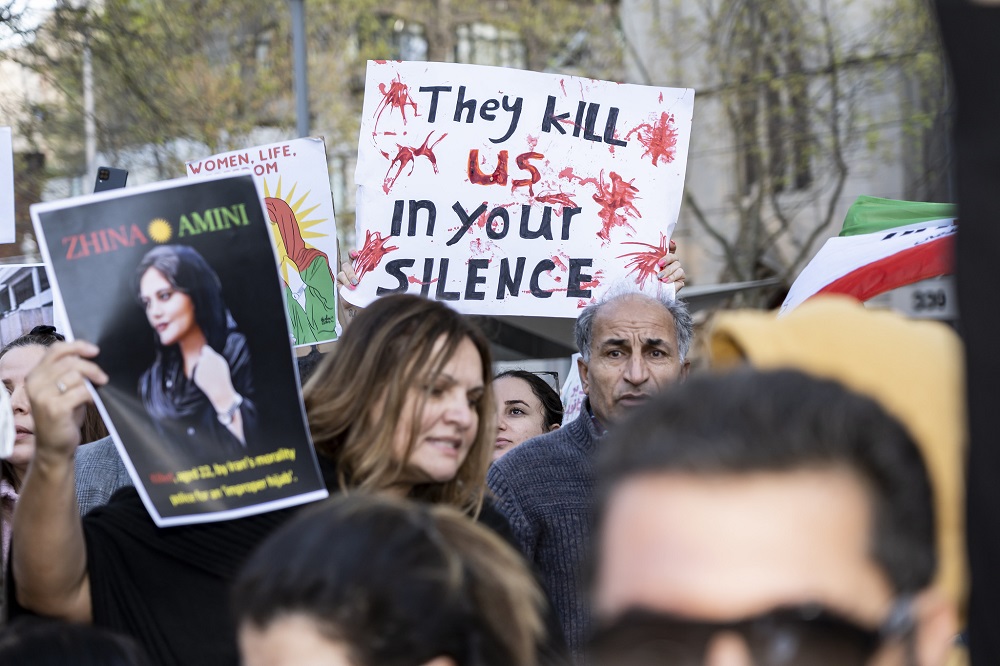Kurds and other minorities account for half of all Iran protest deaths

Luke James
Half of all people killed in Iran during the protests over the death of Jina Amini were from ethnic minority regions including her home province of Kurdistan, figures analysed by Nation.Cymru show.
At least 488 people, including 64 children and 39 women, have lost their lives in the brutal crackdown on protests sparked by the death of the 22-year-old at the hands of Iran’s morality police six months ago today, according to figures published by NGO, Iran Human Rights.
Some 239 of those people were from just three of Iran’s 31 provinces: Amini’s home province of Kurdistan, as well as Sistan and Baluchistan, and West Azerbaijan.
That’s despite the fact the three provinces combined account for less than 10% of Iran’s population of 84 million.
By comparison, 58 people were killed in Iranian capital Tehran, which has a population of 13.9 million and was one of the centres of the protest movement.
The figures reflect the ethnic discrimination in Iran which many believe played a part in the brutal treatment of Amini by Iran’s morality police.
“At the very least we can say there’s a possibility she experienced such brutality because of her ethnicity,” Dr Farangis Ghaderi of Exeter University’s Institute of Arab and Islamic Studies said at the time of Amini’s death.
“We need to remember that we’ve had reports of morality police violence against women, reports of broken arms, broken legs in some cases, but never to the extent that Jina Amini experienced.”
Amini was arrested during a visit to Tehran for wearing her headscarf “incorrectly”. After two hours in police custody, she was taken to a hospital in Tehran where she died two days later.
Unprecedented protest
The events sparked an unprecedented protest movement for women’s rights inside Iran and around the world, including in Wales where a protest was held on the steps of the Senedd.
The first mass protest took place after Amini’s funeral in Kurdistan, where 53 people were killed during the protests.
Kurdistan was the province where the highest number of protests took place between September and December last year, according to an analysis by the US-based Institute for the Study of War.
“We as Kurds have been struggling and fighting for our rights, such as Kurdish language and preserving our culture, for decades,” said Salah Baba Rasool, chair of the Kurdish All Wales Association.
“We have been suppressed for generations and when Jina died it was like a volcano erupted. That’s why the regime is taking every opportunity to destroy us.”
As well as a higher number of protests in Kurdistan and other minority regions, human rights groups also say Iranian police used more excessive force in provinces home to ethnic minorities.
Sistan and Baluchistan, home of the Baluch minority, is the province where the highest number of protestors were killed (132) despite the fact more protests took place in seven other provinces.
The darkest day in the crackdown on the protests came in Zahedan, the capital of Sistan and Baluchistan, when Iranian police positioned on rooftops opened fire on protestors gathered outside a mosque.
Bloody Sunday
A young boy was among at least a dozen victims of what became known as “Bloody Sunday”, according to Human Rights Watch, who subsequently called on the UN to “pay special attention to security force atrocities in minority-dominant areas.”
Another province home to an ethnic minority, West Azerbaijan, has the third highest death toll (54). Although the Kurdistan Human Rights Network say many of the victims were ethnic Kurds.
“Ethnic minorities are subjected to more suppression and there is also more protests and opposition against the regime in these areas,” Mahmood Amiry-Moghaddam, the director of Iran Human Rights, told Nation.Cymru.
“The Iranian regime has always used harder crackdown methods in the ethnic regions, specially Baluchistan and Kurdistan.
“The same is with the use of the death penalty. The Baluch minority accounts for 2-5% of Iran’s population and 25-30% of all executions in the past 2 years.
“More than 50% of all those executed for political and security related charges in the past 12 years are Kurds.”
In an effort to quell discontent, the Iranian authorities announced on Monday that it was pardoning 22,000 people arrested as part of the crackdown on the protests.
But the suspected poisoning of around 1,000 schoolgirls across the country in a bid to stop them accessing education is only fueling anger with the regime and protesters are expected to take the streets again around Persian new year on March 20.
Support our Nation today
For the price of a cup of coffee a month you can help us create an independent, not-for-profit, national news service for the people of Wales, by the people of Wales.





A little reading goes along way, the Kurdish / Iranian conflict was the first battle of the Cold War, Stalin refused to leave as the western allies left…
Anyone is invited to disabuse me of this understanding…